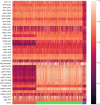Genetic-based patient stratification in Alzheimer's disease
- PMID: 38693203
- PMCID: PMC11063050
- DOI: 10.1038/s41598-024-60707-1
Genetic-based patient stratification in Alzheimer's disease
Erratum in
-
Author Correction: Genetic-based patient stratification in Alzheimer's disease.Sci Rep. 2024 May 21;14(1):11619. doi: 10.1038/s41598-024-62454-9. Sci Rep. 2024. PMID: 38773188 Free PMC article. No abstract available.
Abstract
Alzheimer's disease (AD) shows a high pathological and symptomatological heterogeneity. To study this heterogeneity, we have developed a patient stratification technique based on one of the most significant risk factors for the development of AD: genetics. We addressed this challenge by including network biology concepts, mapping genetic variants data into a brain-specific protein-protein interaction (PPI) network, and obtaining individualized PPI scores that we then used as input for a clustering technique. We then phenotyped each obtained cluster regarding genetics, sociodemographics, biomarkers, fluorodeoxyglucose-positron emission tomography (FDG-PET) imaging, and neurocognitive assessments. We found three clusters defined mainly by genetic variants found in MAPT, APP, and APOE, considering known variants associated with AD and other neurodegenerative disease genetic architectures. Profiling of these clusters revealed minimal variation in AD symptoms and pathology, suggesting different biological mechanisms may activate the neurodegeneration and pathobiological patterns behind AD and result in similar clinical and pathological presentations, even a shared disease diagnosis. Lastly, our research highlighted MAPT, APP, and APOE as key genes where these genetic distinctions manifest, suggesting them as potential targets for personalized drug development strategies to address each AD subgroup individually.
© 2024. The Author(s).
Conflict of interest statement
The authors declare no competing interests.
Figures





References
-
- Marasco RA. Economic burden of Alzheimer disease and managed care considerations. Am. J. Manag. Care. 2020;26:S171–S183. - PubMed
-
- Craig J. Complex diseases: Research and applications. Nat. Educ. 2008;1(1):184.
Publication types
MeSH terms
Substances
Grants and funding
LinkOut - more resources
Full Text Sources
Medical
Miscellaneous

